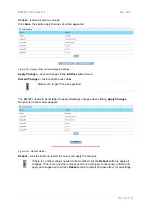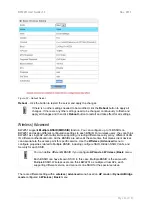
BW2251 User Guide v1.0
Nov. 2013
Page 43 of 187
Figure 54 – Edit Basic Wireless Settings with DCA enabled
Radio Name –
specify wireless interface of BW2251 is shown
Mode
– configure the radio operation mode. [AP mode or Dynamic Bridge mode]. There will be
different configuration for the two mode within
Wireless | Advanced
menu. Please refer to
corresponding chapter.
Selecting the AP Mode:
Domain
– select the regulatory domain.
Channel
– select the channel that the access point will use to transmit and receive information. If one
channel is defined, it acts as default channel. Channels list will vary depending on selected regulatory
domain and selected band. If you wish to operate more than one access point in overlapping
coverage areas, we recommend at least four channels interval between the chosen channels. For
example, for three Access Points in close proximity choose channels 1, 6 and 11 for 11b/g or
channels 36, 40 and 64 for 11a.
Band
– show the working bands on which the radio is working.
wlan1:four bands listed: 2.4GHz(11g only) , 2.4GHz(11n HT20) , 2.4GHz(11n HT20/40plus),
2.4GHz(11n HT20/40minus)
wlan2: four bands listed:5GHz(11a), 5GHz(11n HT20) , 5GHz(11n HT20/40plus), 5GHz(11n
HT20/40minus) .
TxPower
– the BW2251 transmission output power in dBm.
The value of the TxPower varies according to channel and regulatory domain.
RTS Threshold
– the AP sends Request to Send(RTS) frames to a particular receiving station and
negotiates the sending of a data frame. After receiving an RTS, the wireless station responds with a
Clear to Send(CTS) frame to acknowledge the right to begin transmission. The default value is
2347.[recommend]
















































